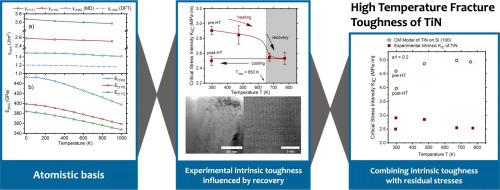当前位置:
X-MOL 学术
›
Mater. Des.
›
论文详情
Our official English website, www.x-mol.net, welcomes your feedback! (Note: you will need to create a separate account there.)
Fracture properties of thin film TiN at elevated temperatures
Materials & Design ( IF 8.4 ) Pub Date : 2020-09-01 , DOI: 10.1016/j.matdes.2020.108885 J. Buchinger , L. Löfler , J. Ast , A. Wagner , Z. Chen , J. Michler , Z.L. Zhang , P.H. Mayrhofer , D. Holec , M. Bartosik
Materials & Design ( IF 8.4 ) Pub Date : 2020-09-01 , DOI: 10.1016/j.matdes.2020.108885 J. Buchinger , L. Löfler , J. Ast , A. Wagner , Z. Chen , J. Michler , Z.L. Zhang , P.H. Mayrhofer , D. Holec , M. Bartosik

|
Abstract We provide an experimental and theoretical description of the high temperature fracture behaviour of TiN thin films. For this, we employ molecular dynamics and density functional theory, to show that the surface energies drop insignificantly between 0 and 1000 K. We utilise these results to predict a slight decrease of the fracture toughness over the aforementioned temperature range. For the experimental perspective, we use unbalanced DC reactive magnetron sputtering to synthesise a TiN film, on which we perform in situ high temperature microcantilever bending tests. Upon increasing the testing temperature from room temperature to 773 K our results present a slight, irreversible decrease of KIC, once the deposition temperature of the film (~653 K) is exceeded. Based on our theoretical groundwork, as well as complementary data produced by X-ray diffraction, nanoindentation, transmission electron microscopy, and wafer curvature measurements, we identify growth defect recovery as the main reason behind the decrease of KIC. We observe no change in the deformation and/or fracture mechanism of TiN across the experimentally investigated temperature range. Using an analytical model based on continuum mechanics, we estimate the influence of macro residual stresses on the temperature-dependent fracture toughness of TiN attached to a Si (100) wafer.
中文翻译:

TiN薄膜在高温下的断裂特性
摘要 我们提供了 TiN 薄膜高温断裂行为的实验和理论描述。为此,我们采用分子动力学和密度泛函理论,表明表面能在 0 到 1000 K 之间的下降微不足道。我们利用这些结果预测在上述温度范围内断裂韧性略有下降。从实验的角度来看,我们使用不平衡直流反应磁控溅射来合成 TiN 薄膜,我们在其上进行了原位高温微悬臂梁弯曲测试。将测试温度从室温提高到 773 K 后,我们的结果表明,一旦超过薄膜的沉积温度(~653 K),KIC 就会出现轻微的、不可逆的下降。基于我们的理论基础,以及通过 X 射线衍射、纳米压痕、透射电子显微镜和晶片曲率测量产生的补充数据,我们确定生长缺陷恢复是 KIC 降低的主要原因。我们观察到在实验研究的温度范围内,TiN 的变形和/或断裂机制没有变化。使用基于连续介质力学的分析模型,我们估计宏观残余应力对附着在 Si (100) 晶片上的 TiN 的温度相关断裂韧性的影响。我们观察到在实验研究的温度范围内,TiN 的变形和/或断裂机制没有变化。使用基于连续介质力学的分析模型,我们估计宏观残余应力对附着在 Si (100) 晶片上的 TiN 的温度相关断裂韧性的影响。我们观察到在实验研究的温度范围内,TiN 的变形和/或断裂机制没有变化。使用基于连续介质力学的分析模型,我们估计宏观残余应力对附着在 Si (100) 晶片上的 TiN 的温度相关断裂韧性的影响。
更新日期:2020-09-01
中文翻译:

TiN薄膜在高温下的断裂特性
摘要 我们提供了 TiN 薄膜高温断裂行为的实验和理论描述。为此,我们采用分子动力学和密度泛函理论,表明表面能在 0 到 1000 K 之间的下降微不足道。我们利用这些结果预测在上述温度范围内断裂韧性略有下降。从实验的角度来看,我们使用不平衡直流反应磁控溅射来合成 TiN 薄膜,我们在其上进行了原位高温微悬臂梁弯曲测试。将测试温度从室温提高到 773 K 后,我们的结果表明,一旦超过薄膜的沉积温度(~653 K),KIC 就会出现轻微的、不可逆的下降。基于我们的理论基础,以及通过 X 射线衍射、纳米压痕、透射电子显微镜和晶片曲率测量产生的补充数据,我们确定生长缺陷恢复是 KIC 降低的主要原因。我们观察到在实验研究的温度范围内,TiN 的变形和/或断裂机制没有变化。使用基于连续介质力学的分析模型,我们估计宏观残余应力对附着在 Si (100) 晶片上的 TiN 的温度相关断裂韧性的影响。我们观察到在实验研究的温度范围内,TiN 的变形和/或断裂机制没有变化。使用基于连续介质力学的分析模型,我们估计宏观残余应力对附着在 Si (100) 晶片上的 TiN 的温度相关断裂韧性的影响。我们观察到在实验研究的温度范围内,TiN 的变形和/或断裂机制没有变化。使用基于连续介质力学的分析模型,我们估计宏观残余应力对附着在 Si (100) 晶片上的 TiN 的温度相关断裂韧性的影响。


























 京公网安备 11010802027423号
京公网安备 11010802027423号